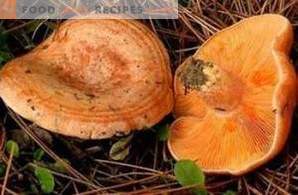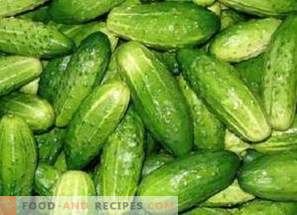
Among the variety of mushrooms, there are both gray, almost imperceptible on the background of their surroundings, and handsome men, on whom it is a pleasure to look These mushrooms include chanterelles. Probably, they were called so for a bright yellow-orange outfit and a skatery hat.
While chanterelles are small, they look almost the same as the rest of the young mushroom: a convex cap on a dense stem. But as the fungus grows, the hat straightens out, bends inward, forming something like a funnel with beautiful wavy edges.
Collect chanterelles - a pleasure! After all, their main advantage is that they are almost never wormy. And all thanks to their composition.
- Chanterelles contain an unusual substance - chitinmanose, which destroys all kinds of helminths and their similarity.
- Also found in chanterelles is ergosterol, a substance that can clean the liver.
- Chanterelles are rich in vitamins PP, A, B, beneficial trace elements such as zinc, copper, selenium, manganese.
- The chanterelles have very few calories, so they can be eaten by those who watch their figure.
Where chanterelles grow
Most often chanterelles are found in deciduous and mixed forests, but sometimes they come across in conifers. They love the soil covered with moss and leaves. They practically do not appear where thick thickets and tall grass. Chanterelles coexist in symbiosis with spruce, beech, oak, pine. Often hiding under the moss, so despite the bright, visible appearance, they are not so easy to notice. And if the earth is covered with yellowing leaves, then they can be easily confused with them.
But if at least one mushroom is noticed, then you should carefully look around, bend over, raise the moss with your wand ... After all, chanterelles grow in families, which means another group of mushrooms has lurked nearby.
By the way, the moss may not necessarily be green. There is light moss on sandy soils, under which chanterelles can also hide.
Experienced mushroom pickers, knowing the ability of chanterelles on dry days, simply fall into hibernation, look for mushrooms in wet, overgrown grass, lowlands. And on rainy days, chanterelles, on the contrary, settle in sunny glades or small hills, but still try to keep close to birch, oak, beech, spruce, pine.
In mixed forests, sometimes you can find chanterelle false. It differs from the real chanterelle by more reddish plates, a hat with smooth, non-wavy edges and a hollow stem. Unlike a real chanterelle, from which the fruit aroma emanates, a false chanterelle has a very unpleasant smell. Opinions about edible chanterelle radically diverge. Some believe that it is almost a poisonous mushroom, and in some books they write that the false chanterelle is quite edible. Therefore, it is worthwhile to bypass it and collect only proven mushrooms.
When Chanterelles Grow
Chanterelles grow from June to October. But in June, when the first layer of mushrooms appears, they are less common. The main growth of chanterelles is in July-August months, especially after warm thunderstorm rains.
And if the hot weather suddenly sets in, in which many mushrooms simply disappear, chanterelles only temporarily stop their growth, as if they stop, so that after the first rain it starts to grow again. And as adults, they simply dry up on the vine.
How to collect chanterelles
They are very convenient to collect and store until processing, because, folded in a basket, they do not break, do not crumble, because they have elastic rubbery flesh.
We must not forget that chanterelles grow for a very long time, and when grown up, they do not deteriorate, therefore it is not recommended to collect overgrown individuals, even if they look attractive. After all, they can accumulate a lot of toxins and harmful substances.











































